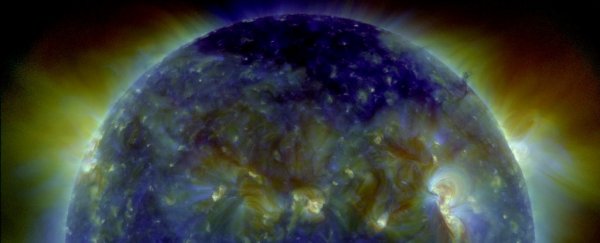If you live at a high latitude, it's time to break out the camera. Space weather agencies are predicting a solar storm for Monday 27 September: moderate, with a chance of aurora.
The US National Oceanic and Atmospheric Administration (NOAA) and the British Met Office have both issued predictions for the storm, which is predicted to be the result of several solar coronal mass ejections (CMEs), and solar winds unleashed from a "hole" that has opened up in the Sun's corona.
Although there could be as many as four CMEs that could affect Earth, you don't have to fret. The storm will only get as high as a level G2 – relatively mild on the five-level solar storm scale, on which G5 is the strongest.
At high latitudes, the predicted G2 storm may cause power grid fluctuations; satellite orientation may be affected, with increased drag at low-Earth orbit; and high-frequency radio propagation may fade.
But we may be in for a treat, too: "Aurora may be seen as low as New York to Wisconsin to Washington state," the NOAA wrote in its alert.
Solar storms are a part of pretty normal space weather, and in the coming few years, we can probably expect to see more of them. They occur when the Sun gets a little rowdy, in the form of CMEs and solar winds, causing disruptions to Earth's magnetic field and upper atmosphere.
CMEs are pretty much exactly what they sound like. The Sun's corona – the outermost region of its atmosphere – erupts, ejecting plasma and magnetic fields into space. If the CME is oriented at Earth, the collision of the solar ejecta with Earth's magnetic field can cause a geomagnetic storm – also known as a solar storm.
Solar winds emerge from 'holes' in the Sun's corona. These are cooler, less dense regions of plasma in the Sun's atmosphere, with more open magnetic fields. These open regions allow the solar winds to escape more easily, blowing electromagnetic radiation into space at high speeds. If the hole is facing Earth, those winds can blow right at us, once again getting all up in our magnetosphere.
The Sun currently has both going on.
"There are four CME which may affect the Earth," the British Met Office explained on its website.
"Three of these could arrive separately or as a single combined feature during 27 September, with a further CME perhaps glancing the earth later on 27 or during 28 September. A coronal hole fast wind may also affect the Earth on 27 and 28 September, although any effects from this wind are considered uncertain.
"There is also a low risk that the CMEs and fast wind may affect the earth at similar times, providing a greater effect. Any enhancements would then ease during 28 and 29 September."
Any charged particles that collide with Earth's magnetic field are sent whizzing along the magnetic field lines towards the poles, where they rain down on Earth's upper atmosphere and collide with atmospheric molecules. The resulting ionization of these molecules generates the stunning dancing lights we call the aurora.
According to Space Weather's aurora forecast, we've got a level of Kp 6 on the ten-point Kp index of geomagnetic activity. This means a strong possibility of bright, dynamic aurora with the likelihood of auroral coronae.
We can also expect more solar storms in the months and years ahead. The Sun is currently heading towards the most active period of its 11-year cycle, called solar maximum. During solar maximum, the solar magnetic field – which controls sunspots (temporary regions of strong magnetic fields), solar flares, and coronal mass ejections – is at its strongest, and so too is solar activity.
Earlier this year, the Sun spat out its most powerful flare since 2017, so our star definitely seems to be waking up. Its sunspot activity is expected to peak in July 2025, after which it will subside back into solar minimum.
